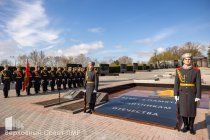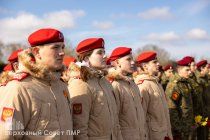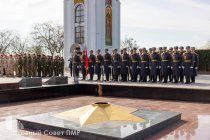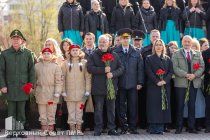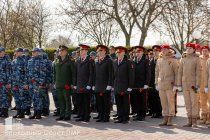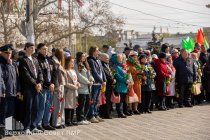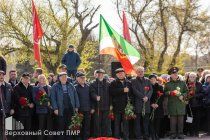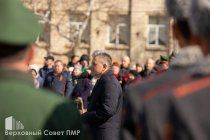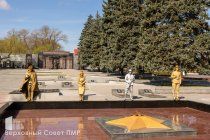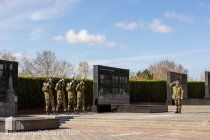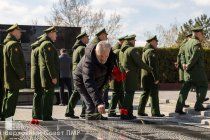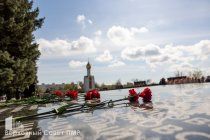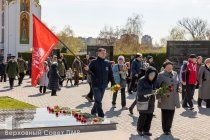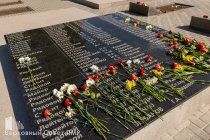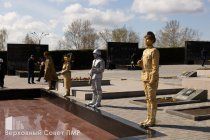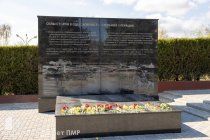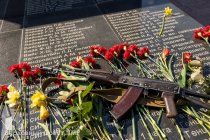 Русский
Русский English
English-







Day of Liberation of Tiraspol from German-Romanian Invaders
The Red Banner was raised in the sky over Tiraspol in 1944, on the 12th of April. 970 tragic days and nights of the Romanian occupation were over. Soldiers of the 37th Army of the 3rd Ukrainian Front liberated the future capital of Pridnestrovie from the German-Romanian invaders
Tiraspol was liberated at the final stage of the Odessa offensive operation. The Red Army forced the armies of the Wehrmacht and its allies to retreat to the west. On the day of the 81st anniversary of the liberation of Tiraspol from the German-Romanian invaders, the Chairman of the Supreme Council of the Pridnestrovian Moldavian Republic Alexander Korshunov addressed the residents of the Pridnestrovian capital.
Alexander Korshunov wished the veterans of the Great Patriotic War, home front workers, Tiraspol residents and all Pridnestrovians good health, long life, prosperity and a peaceful sky above their heads.
On the morning of April 12, the opening of the renovated Glory Memorial took place. The memory of the Soviet soldiers who freed the city from fascist oppression was honored by the leadership of the republic. Fresh flowers were laid at the Eternal Flame and granite slabs with the names of the fallen by the President of the Pridnestrovian Moldavian Republic Vadim Krasnoselsky, Chairman of the Government of the Pridnestrovian Moldavian Republic Alexander Rosenberg, Deputy Chairman of the Supreme Council of the Pridnestrovian Moldavian Republic, deputy for constituency No. 25 "Zapadny" Galina Antyufeeva, deputy of the Supreme Council for constituency No. 29 "Odessa" Igor Buga, heads of ministries and departments, clergy, public figures and concerned residents of the capital. The Memorial of Glory is the most memorable place for Pridnestrovians. The idea of its creation arose in the early 1970s. The residents of Tiraspol themselves took part in the large-scale construction – workers, employees, students. The names of 1252 liberator soldiers were immortalized on the marble slabs. On February 23, 1972, the Eternal Flame was lit by a participant in the Jassy-Kishinev operation, Hero of the Soviet Union Mikhail Kharin. A ceremony of reburial of the remains of Soviet soldiers and officers took place at the same time.
T-34 tank was installed on a pedestal at the Memorial. It was redirected from Hungary to Tiraspol back in April 1945. It traveled a long way from Stalingrad to Hungary. At first, the tank stood on one of the central alleys of the city as a monument to fallen soldiers. It was decided later to move it to the Memorial.
In 1995, a monument to internationalist soldiers was erected at the memorial complex. It was opened by Lieutenant General Alexander Lebed.
The last burials at the Glory Memorial were held in 1992. Participants in the defense of Pridnestrovie from the aggression of the Republic of Moldova are buried here.
A large-scale reconstruction was carried out at the main memorial complex of the republic in 2010 for the 20th anniversary of the formation of Pridnestrovie. 804 names of the fallen defenders of Pridnestrovie appeared on the Wall of Memory. A sculpture of the Grieving Mother was installed nearby.
The opening and consecration of the Chapel of St. George the Victorious took place in October 2011, which was built at the Memorial with the blessing of Bishop Sawa of Tiraspol and Dubossary in memory of the fallen soldiers.
The Glory Memorial was renewed again this year. The work began last summer. The slabs with the names of the dead were updated, and the Eternal Flame bowl was reconstructed. On the instructions of the head of state Vadim Krasnoselsky, new elements appeared on the memorial complex – granite slabs with the names of Tiraspol residents who died on the fronts of the Great Patriotic War, and information panels with key events that took place in Tiraspol in the period 1941-1944.
The PMR President recalled the tragic years of occupation, the mass murders and torture committed by the Romanian occupiers under the leadership of Marshal Antonescu.
Vadim Krasnoselsky called on Pridnestrovians to resist fascism and Nazism with their memory: to come to memorials of glory, congratulate veterans, listen to and write down stories about their ancestors-defenders and pass them on to their children and grandchildren.
The deputy of the Supreme Council, the head of the parliamentary Committee on Education, Public Associations and Mass Media Igor Buga recalled the importance of preserving historical memory.
The central element of the reconstructed Glory Memorial is the monument to the Unknown Soldier, the grand opening of which will take place on April 16. The ceremony of reburial of the remains of the unknown soldier will take place on this day.


